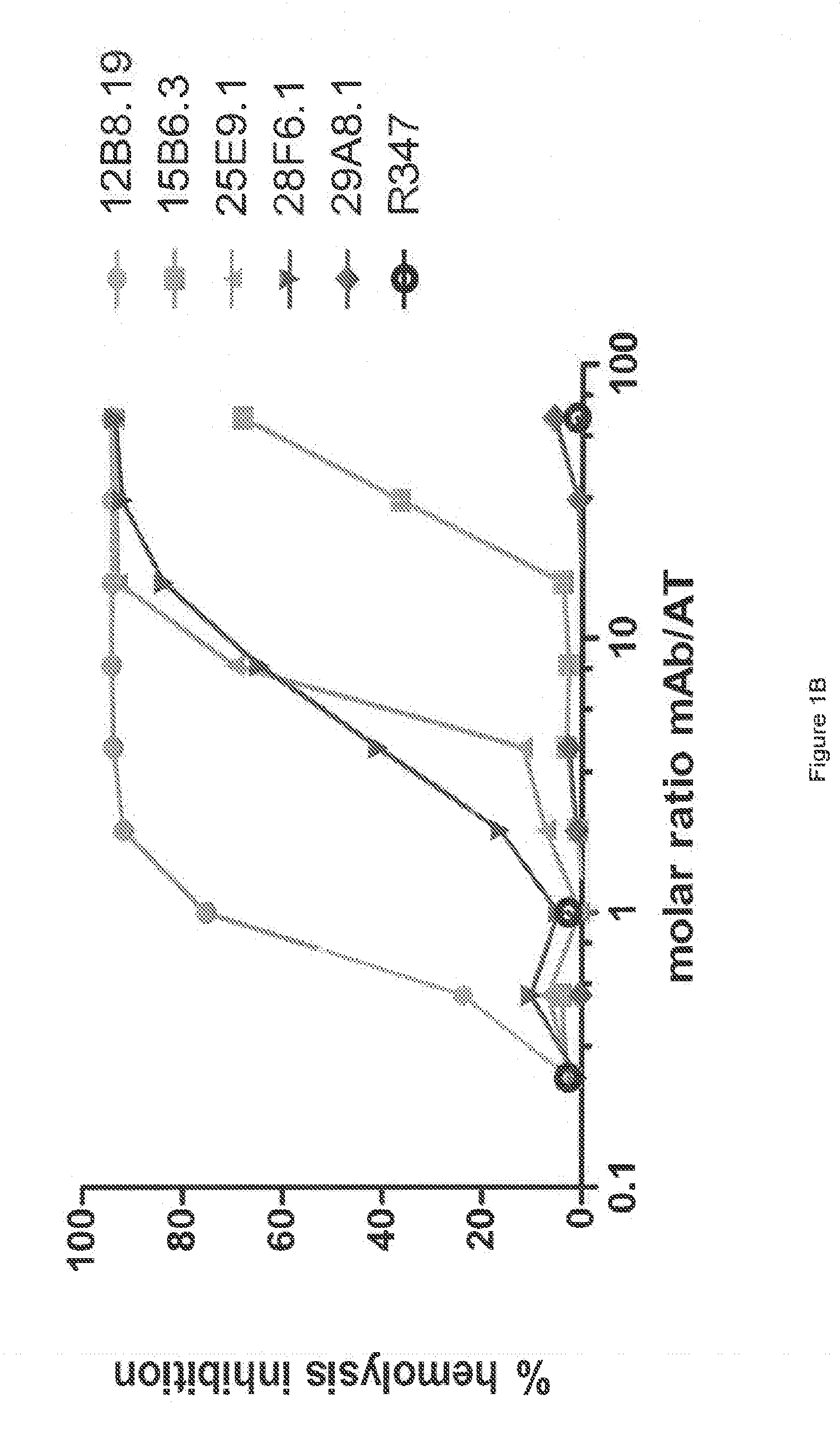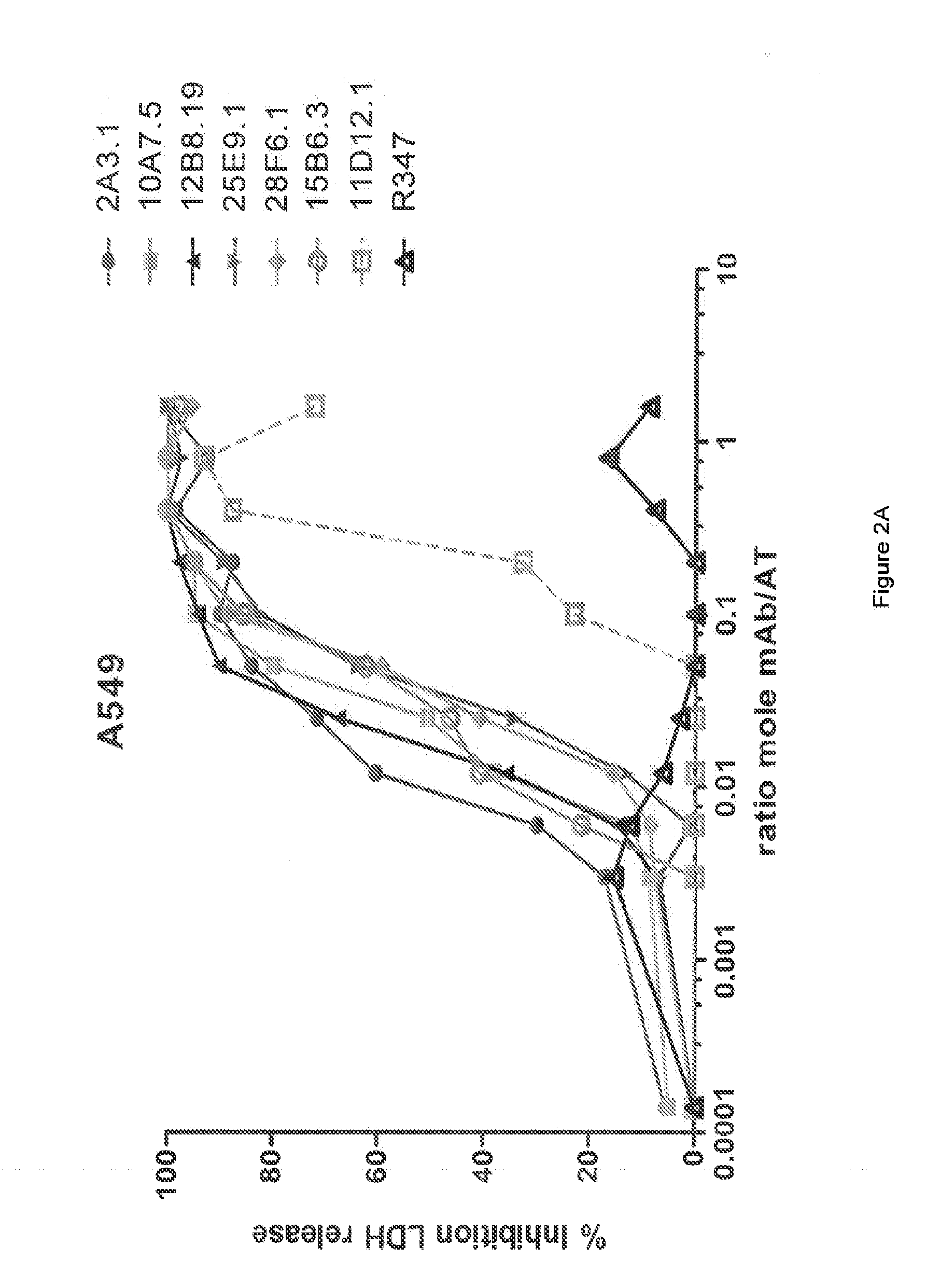Antibodies that specifically bind staphylococcus aureus alpha toxin and methods of use
an antibody and staphylococcus aureus technology, applied in the field of antibodies, can solve the problems of infection and disease in animals, increasing the risk of infection, and reducing so as to prevent, treat or manage the skin infection condition, and reduce the oligomerization of toxin polypeptides
- Summary
- Abstract
- Description
- Claims
- Application Information
AI Technical Summary
Benefits of technology
Problems solved by technology
Method used
Image
Examples
example 1
Materials and Methods
[0312]Materials and methods utilized for Example 2 to Example 9 and Example 11 to Example 13 are provided hereafter.
[0313]Cloning and Expression of Wt S. Aureus AT and Non-Hemolytic Mutant H35L
[0314]Genomic DNA from Staphylococcus aureus strain ATCC BAA1556 was used to amplify the wild type alpha toxin (AT) gene by PCR. The reaction contained forward primer, atatatgagctcgcagattctgatattaatattaaaacc (SEQ ID NO: 41), reverse primer, atatataagcttaatttgtcatttcttctttttccc (SEQ ID NO: 42), and approximately 10 ng of genomic DNA in a 50 μl reaction using Herculase II polymerase (Stratagene). The resultant fragment was digested with Sac I and Hind III and ligated into the pCold II DNA vector (TaKaRa), in frame with an N terminal 6×His tag. The H35L mutant was generated by site directed mutagenesis of the wild type gene using a QuikChange II XL site directed mutagenesis kit (Stratagene), according to manufacturer's instructions. The mutagenic primers utilized for the muta...
example 2
Anti-Alpha Toxin mAb Generation
[0365]Anti-alpha toxin (AT) monoclonal antibodies (mAbs) were generated in VelocImmune mice which have been genetically engineered to contain an antibody repertoire with fully human variable regions fused to murine constant domain. The resulting antibodies are human:mouse chimeras which are easily converted to fully human IgG by genetically fusing the human variable domain from the chimeric mAb with the constant regions from a cloned human IgG-1. Mice were immunized with a nonhemolytic AT mutant (ATH35L), described herein, and hybridomas were generated using standard methods. Initially, greater than 1800 hybridoma supernatants were found to contain IgG that bound recombinant AT (rAT-his) by antigen ELISA. The hybridoma supernatants which exhibited binding to rAT-his were then screened for activity by inhibition of rAT-his mediated lysis of rabbit red blood cells (RBC) in a hemolytic assay, whereby, the pool of functional mAbs was reduced to about 250. ...
example 3
Inhibition of Cytolytic Activity
[0366]The inhibitory activities of the 13 purified anti-AT IgG were compared in a hemolytic assay. Purified anti-AT mAbs were titrated in a hemolytic assay in the presence of constant quantities of nAT and rabbit red blood cells. The mAbs were each titrated down from about 20 μg / mL in the presence of a constant amount of native AT (nAT) and rabbit red blood cells (RBC). Hemolysis was measured by the hemoglobin release into the supernatant. Percent (%) hemolysis inhibition was calculated as follows: % inhibition=100*[100-(A490 nAT+Ab) / (A490 nAT no Ab)]. Representative hemolytic assays demonstrating the thirteen most potent rAT-his inhibitors are shown in FIGS. 1A and 1B. A non-specific IgG control (R347) was included as a negative control.
[0367]Only 7 of the 13 purified mAbs (mAbs; 2A3.1, 10A7.5, 11D12.1, 12B8.19, 15B6.3, 25E9.1 and 28F6.1) inhibited nAT mediated RBC lysis (see FIGS. 1A and 1B). Three of the antibodies (2A31., 10A7.5 and 12B8.19) were ...
PUM
| Property | Measurement | Unit |
|---|---|---|
| Fraction | aaaaa | aaaaa |
| Fraction | aaaaa | aaaaa |
| Fraction | aaaaa | aaaaa |
Abstract
Description
Claims
Application Information
 Login to View More
Login to View More - R&D
- Intellectual Property
- Life Sciences
- Materials
- Tech Scout
- Unparalleled Data Quality
- Higher Quality Content
- 60% Fewer Hallucinations
Browse by: Latest US Patents, China's latest patents, Technical Efficacy Thesaurus, Application Domain, Technology Topic, Popular Technical Reports.
© 2025 PatSnap. All rights reserved.Legal|Privacy policy|Modern Slavery Act Transparency Statement|Sitemap|About US| Contact US: help@patsnap.com



